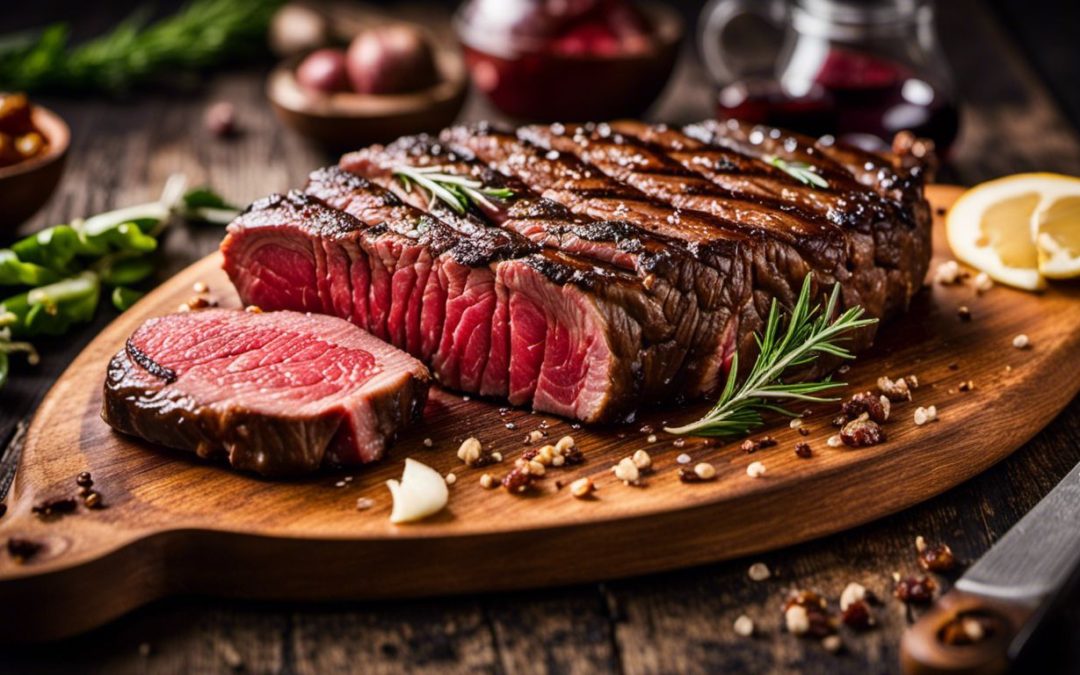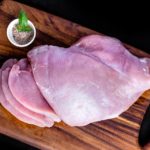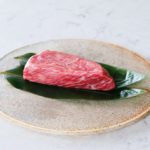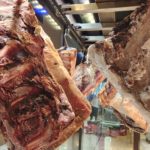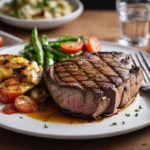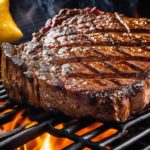Ever felt overwhelmed by the abundance of beef steak cuts at your local butcher? We’ve been there, staring blankly at T-bones, sirloins and porterhouses, unsure which to choose for Saturday night’s BBQ.
After digging into research and consulting with meat experts, we’ve created a detailed guide to help you navigate through the flavorful world of premium beef steaks. Prepare your taste buds as we delve into this juicy topic guaranteed to make every carnivore’s heart (and stomach) happy!
Key Takeaways
- Ribeye is a popular premium beef steak cut known for its rich marbling and deliciously juicy flavor.
- Strip Steak, also known as New York Strip, is a flavorful and tender cut of beef that is perfect for grilling or pan-searing.
- Tenderloin/Filet Mignon is an exceptionally tender and luxurious beef steak cut that requires minimal seasoning but delivers maximum taste.
- T – Bone and Porterhouse steaks offer the best of both worlds with a combination of tenderloin and strip, making them ideal for special occasions.
The Most Common Cuts of Premium Beef Steak
The most common cuts of premium beef steak include ribeye, strip steak (New York Strip), tenderloin/filet mignon, T-bone and Porterhouse, top sirloin, and flank steak.
Ribeye
Beloved by many meat enthusiasts, the ribeye is a premium steak cut that strikes an exceptional balance between flavor and tenderness. Its signature feature is the rich marbling – streaks of fat interspersed within the lean meat, which melt as it cooks to deliver a deliciously juicy and flavorful bite.
The ribeye comes from the beef’s rib section where muscles are less used. Less usage means more tenderness! No fancy cooking techniques required here; a simple seasoning, grilling or searing in high heat can flawlessly bring out its taste.
Gourmet steak cuts like these make your home-cooked meals taste straight out of a fine-dining restaurant!
Strip Steak (New York Strip)
Strip Steak, also known as New York Strip, is a popular and flavorful cut of premium beef. It comes from the strip loin area of the cow, which means it’s tender and juicy. This steak has a nice balance of lean meat and marbling, giving it a rich flavor that will satisfy any meat lover.
When cooking Strip Steak, you have several options to bring out its best qualities. You can grill it to perfection for those beautiful grill marks and smoky flavors. Pan-searing is another great method to seal in the juices and create a delicious crust on the outside.
No matter how you cook it, be sure to season with salt and pepper or your favorite spices for an added burst of flavor.
Whether you’re enjoying a night at home or impressing guests with your culinary skills, Strip Steak is always a crowd-pleaser. Its tenderness and bold taste make it one of the top choices for steak connoisseurs everywhere.
Tenderloin/Filet Mignon
Tenderloin, also known as Filet Mignon, is considered one of the most tender and luxurious cuts of beef. It comes from the area just below the backbone of the cow and has a fine texture and mild flavor.
This cut is highly prized for its tenderness and is often associated with fine dining experiences. When cooked properly, it practically melts in your mouth. Due to its tenderness, it doesn’t require much marinating or seasoning to enhance its natural flavors.
Instead, simple seasonings like salt and pepper are commonly used to bring out its exquisite taste.
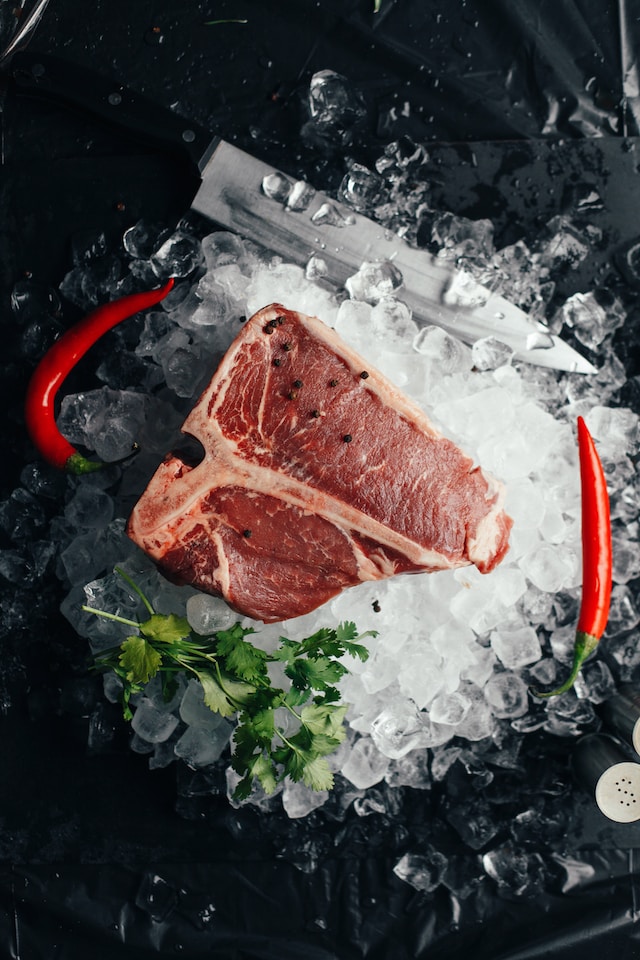
T-Bone & Porterhouse
T-Bone and Porterhouse steaks are two popular cuts of premium beef that meat lovers can’t resist. They both come from the short loin section of the beef, which means they have a tender and flavorful taste.
The main difference between these two cuts is the size of the tenderloin muscle. T-Bone steaks have a smaller amount of tenderloin, while Porterhouse steaks have a larger portion. This means that Porterhouse steaks offer an extra juicy and melt-in-your-mouth experience.
When it comes to cooking, these cuts are best enjoyed grilled or pan-seared to lock in their natural flavors. The T-shaped bone adds extra richness to the meat as it cooks, making them perfect for special occasions or when you want to indulge in a delicious steak dinner.
Top Sirloin
Top Sirloin is a popular and flavorful cut of beef that offers a balance of tenderness and affordability. It comes from the sirloin primal cut, which is located in the rear portion of the cow.
The top sirloin is leaner compared to other cuts, but still boasts rich flavor with a firm texture. This versatile cut can be grilled, broiled, or pan-seared for maximum taste. It’s perfect for those who want to enjoy a delicious steak without breaking the bank.
With its juicy tenderness and affordable price point, top sirloin is an excellent choice for any meat lover looking to satisfy their cravings.
Flank Steak
Flank steak is a popular and flavorful cut of beef that meat lovers should definitely try. This lean and long muscle comes from the abdominal area of the cow, which means it has a rich and beefy flavor.
It’s known for its distinct grainy texture, which makes it perfect for marinating and grilling. Flank steak can be quite tough if not cooked properly, so it’s important to tenderize it by scoring or pounding before cooking.
When grilled to perfection, flank steak becomes incredibly juicy and delicious. So fire up the grill, season with your favorite marinade, let it rest for a few minutes, then slice against the grain for tender and flavorful bites of mouthwatering goodness!
Characteristics and Cooking Recommendations for Each Cut
When it comes to enjoying a premium beef steak cut, knowing the characteristics of each cut and how best to cook it can make a world of difference. Let’s dig into the delectable details of each cut and how to cook them to perfection.
| Cut | Characteristics | Cooking Recommendations |
|---|---|---|
| Ribeye | Rich in flavor and perfectly marbled, ribeye cuts are among the most popular steak cuts. | Best when grilled or broiled to medium-rare to medium. |
| Strip Steak (New York Strip) | A lean cut with a rich, beefy flavor, the strip steak is known for its tenderness. | Great for grilling, broiling, or pan-searing. |
| Tenderloin/Filet Mignon | The tenderloin or filet mignon is exceptionally tender with a mild flavor. | Best cooked using high-heat searing and then finished in the oven. |
| T-Bone & Porterhouse | These cuts offer the best of both worlds with a portion of tenderloin and strip separated by a T-bone. | Grill or broil to medium-rare, being careful not to overcook the tenderloin portion. |
| Top Sirloin | A balance of tenderness and rich flavor, the top sirloin is a lean and boneless cut. | It lends itself well to grilling, broiling, or pan-frying. |
| Flank Steak | Flank steak is lean, somewhat tough but full of flavor. | It’s best marinated and grilled or broiled, then sliced against the grain. |
Remember, each of these cuts carries unique characteristics and flavors, making them standout choices for just about any steak lover. Whether grilling on a sunny day or cozying up with a pan-seared steak, we’re confident you can make the most of these premium cuts. Happy grilling!
Differences Between Bone-In and Boneless Steaks
Bone-in and boneless steaks offer different dining experiences. With bone-in steaks, like T-bone or Porterhouse, the bone not only adds flavor but also helps retain moisture during cooking.
On the other hand, boneless steaks, such as ribeye or strip steak, are known for their tenderness and ease of eating.
When it comes to taste, bone-in steaks often have a richer flavor due to the marbling and proximity to the bone. They can also take longer to cook because of their larger size. Boneless steaks, however, are typically quicker to prepare since they don’t require additional time for cooking the bone.
Whether you prefer a juicy steak with extra flavor from the bone or a tender cut that’s easy to eat without any bones getting in your way is all based on personal preference. The important thing is knowing what type of steak you’re looking for when ordering at a restaurant or buying from a butcher.
In summary:
– Bone-in steaks provide enhanced flavors and retained moisture during cooking.
– Boneless steaks offer tenderness and convenience in terms of eating.
– Both types have their own unique qualities that appeal to different tastes.
– Understanding these differences allows you to make informed decisions when choosing your preferred cut of beef steak.
The Importance of Marbling in Premium Beef Steak
Marbling is a critical factor when it comes to premium beef steak. It refers to the thin streaks of fat that are interspersed within the muscle fibers of a cut of meat. This marbling plays a significant role in enhancing the flavor, tenderness, and juiciness of the steak.
When you cook a steak with good marbling, the fat melts during cooking, infusing the meat with its rich flavors. The result is an incredibly flavorful and moist piece of steak that will leave your taste buds craving for more.
Not only does marbling enhance the taste, but it also adds tenderness to the meat. The intramuscular fat helps to keep the beef juicy and prevents it from becoming dry during cooking.
So, whether you prefer your steak rare or well-done, marbled cuts ensure that every bite is tender and succulent.
In summary, marbling is what sets premium beef steaks apart from other cuts. It contributes to both flavor and texture by adding richness and moisture throughout the meat. So next time you’re at your local butcher or grocery store looking for a top-quality steak, be sure to look for those beautiful flecks of fat running through the muscle – they’re worth their weight in gold!
Conclusion
In conclusion, “The Complete Guide to Premium Beef Steak Cuts” is the ultimate resource for meat lovers looking to elevate their steak game. With detailed information on various cuts, cooking recommendations, and the importance of marbling, this guide will turn you into a true steak connoisseur.
So grab your apron and get ready to impress with perfectly cooked premium beef steaks that will have everyone asking for seconds!
FAQs
1. What are the different premium beef steak cuts I should know about?
Some of the popular premium beef steak cuts include ribeye, tenderloin (filet mignon), striploin (New York strip), T-bone, and porterhouse.
2. How do I choose the right premium beef steak cut for my meal?
Choosing the right premium beef steak cut depends on your personal preference and desired level of tenderness. Ribeye is known for its rich flavor, while tenderloin offers a melt-in-your-mouth texture. Consider factors like marbling, thickness, and cooking method to make an informed choice.
3. What is the best way to cook premium beef steaks?
The best way to cook premium beef steaks is subjective and varies based on personal taste. However, popular methods include grilling, pan-searing, or broiling. It’s important to properly season the steaks beforehand and monitor their internal temperature using a meat thermometer for desired doneness.
4. Are there any specific tips for selecting and storing premium beef steak cuts?
When selecting a premium beef steak cut, look for vibrant red color with marbling throughout for optimal flavor and tenderness. Ensure that it has been properly stored at appropriate temperatures in a refrigerated display case or vacuum-sealed packaging at your butcher’s shop before purchase. Once bought, store it in the refrigerator below 40°F (4°C) until ready to cook and consume within a few days for optimal freshness.
Greetings!
With over two decades of diverse experience in the meat industry, I proudly stand as an expert in all things meat. My journey commenced with a strong foundation in hospitality, where I honed my culinary skills as a chef in prestigious restaurants and on luxurious superyachts worldwide.
However, my true passion lies in the art of butchery. Throughout my extensive career, I have had the privilege of working with renowned meat purveyors and mastering the craft of meat cutting and preparation. From breaking down whole carcasses to meticulously selecting prime cuts, my butchery expertise is at the core of my meat knowledge.
Having immersed myself in various cultures and cuisines, I have honed my skills to deliver exceptional dining experiences, crafting delectable dishes that celebrate the natural flavors of different meats. Whether it's sourcing the finest meats for discerning clients or sharing valuable tips on meat selection and cooking, I take pride in elevating the meat experience for both professionals and enthusiasts.
My journey has taken me from the bustling kitchens of top-rated restaurants to the heart of meat processing facilities, gaining insights and honing my skills to become a true meat connoisseur. Now, I am enthusiastic about sharing my expertise, offering valuable insights on meat selection, cooking techniques, and the art of butchery.

